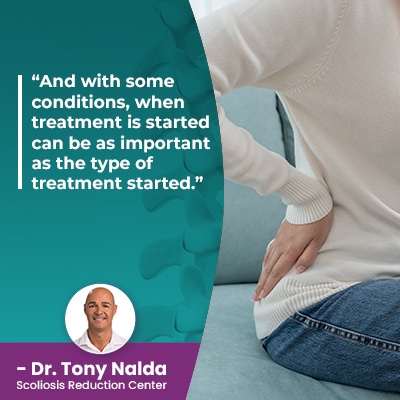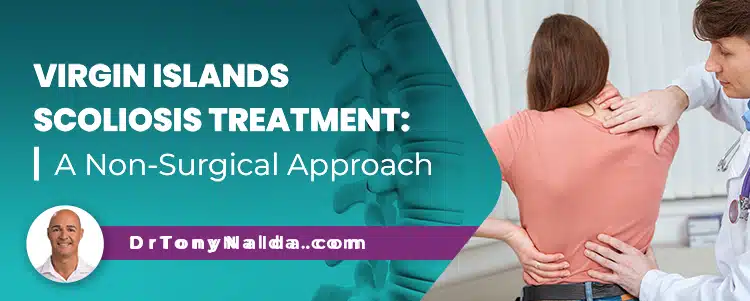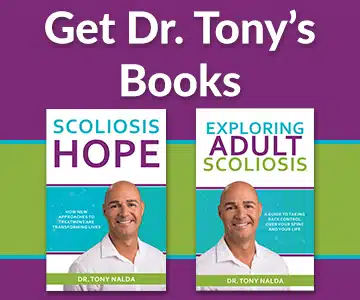If a patient is diagnosed with scoliosis, they have a crucial decision to make: how to treat it moving forward. This is important because as a progressive condition, scoliosis is incurable, but it can be highly treatable. There are two main treatment responses: surgical and non-surgical. Continue reading to find out how each affects the spine differently.
Not all parts of the world can access the same level of care for scoliosis patients. For residents of the Virgin Islands, a 3.5-hour flight puts them within reach of world-renowned, Dr. Tony Nalda, of Celebration, Orlando’s Scoliosis Reduction Center®.
People understandably have a lot of questions when they are diagnosed with scoliosis, so let’s start with how a diagnosis is reached.
Diagnosing Scoliosis
Diagnosing scoliosis means an unnatural lateral (side-to-side) spinal curve has developed, and the spinal curve doesn’t just bend unnaturally, but also twists; it’s the rotational component that makes scoliosis a 3-dimensional condition and sets it apart from a number of other spinal conditions that involve a loss of healthy spinal curves.
Diagnosing scoliosis also involves further classifying conditions based on a number of key patient and condition variables: patient age, condition type, curvature location, and condition severity.
In fact, in order to be diagnosed as scoliosis, there has to be a minimum severity level, and this is determined by a measurement known as Cobb angle.
A patient’s Cobb angle is taken during X-ray and involves drawing lines from the tops and bottoms of the curve’s most-tilted vertebrae, and the intersecting angle is expressed in degrees:
- Mild scoliosis: Cobb angle measurement of between 10 and 25 degrees
- Moderate scoliosis: Cobb angle measurement of between 25 and 40 degrees
- Severe scoliosis: Cobb angle measurement of 40+ degrees
- Very-severe scoliosis: Cobb angle measurement of 80+ degrees
As you can see from the wide range of Cobb angle measurements, scoliosis is a highly-variable condition with no two cases the same, which is why it’s so important that treatment plans are fully customized.

And with some conditions, when treatment is started can be as important as the type of treatment started.
Scoliosis is Progressive
A key condition-characteristic for patients to understand is that as a progressive condition, scoliosis has it in its nature to get worse over time, especially if left untreated.
So scoliosis that’s diagnosed as mild doesn’t mean that’s where it will stay, and as it’s not a static condition, when treatment is started can have far-reaching effects; only proactive treatment can work towards counteracting the condition’s progressive nature.
While there are no treatment guarantees, scoliosis that’s detected early and responded to with proactive treatment started early in a condition’s progressive line, is more likely to respond favorably.
As scoliosis progresses, it gets more difficult to treat; the spine gets more rigid, making it less responsive, and increasing spinal rigidity can make it difficult for some patients to perform certain therapeutic exercises that are part of treatment.
The two main scoliosis treatment approaches start treatment at very different times, and for those wanting a less-invasive non-surgical scoliosis treatment approach, Celebration, Orlando’s Scoliosis Reduction Center® can offer just that.
So if you’re traveling from St. Croix, Charlotte Amalie, and/or Cruz Bay in search of scoliosis treatment, the Sunshine State is an approximate 1235 miles and a 3.5-hour flight away.
Non-Surgical Conservative Scoliosis Treatment
Here at the Center, Dr. Tony Nalda has been treating scoliosis without surgery for over 20 years, and results speak for themselves.
While traditional scoliosis treatment funnels patients towards spinal fusion surgery by not having a strategy for treating scoliosis while mild, modern conservative treatment values starting treatment as close to the time to diagnose as possible.

Treating scoliosis while mild offers the best potential results; the spine is still flexible and responsive, related muscle imbalances are unlikely to have occurred, and the body hasn’t yet had time to adjust to the unnatural spinal curve’s presence.
The reality is that traditional scoliosis treatment doesn’t have a strategy for treating scoliosis while mild so recommends watching and waiting instead, and if/when a patient progresses into the severe classification, they become a surgical candidate.
Conservative treatment also integrates multiple different types of treatment so conditions can be impacted on every level: condition-specific chiropractic care, physical therapy, corrective bracing, and rehabilitation.
Through chiropractic care, I can work towards achieving a curvature reduction on a structural level, and then I shift the focus to increasing core strength so the spine’s optimally supported by its surrounding muscles.
Corrective bracing can be particularly effective on growing spines and can help by pushing the spine into a corrective position, and rehabilitation involves a series of custom-prescribed home exercises to further stabilize and heal the spine.
Conclusion
Virgin Islands residents looking for non-surgical treatment options might not have a number of local choices, but an approximate 3.5-hour flight to Orlando, Florida puts them within reach of the Scoliosis Reduction Center®: an industry-leading non-surgical scoliosis treatment center.
And it’s not like Orlando, Florida has nothing else to offer visitors; there is the infamous Disney World, Universal Studios, SeaWorld, and more.
While traditional scoliosis treatment has been around for many years, that doesn’t mean it’s the best, nor the only treatment option available.
Traditional surgical treatment involves spinal fusion, and while the procedure can indeed straighten a bent spine, it does so by artificial means that cost the spine in terms of its overall health, strength, and function.
Conservative treatment, however, offers a less-invasive more-natural treatment approach that prioritizes preserving as much of the spine’s natural strength and function as possible.
So don’t hesitate to reach out for more information on the different scoliosis treatment approaches available: the choice of one over the other can have far-reaching effects.




